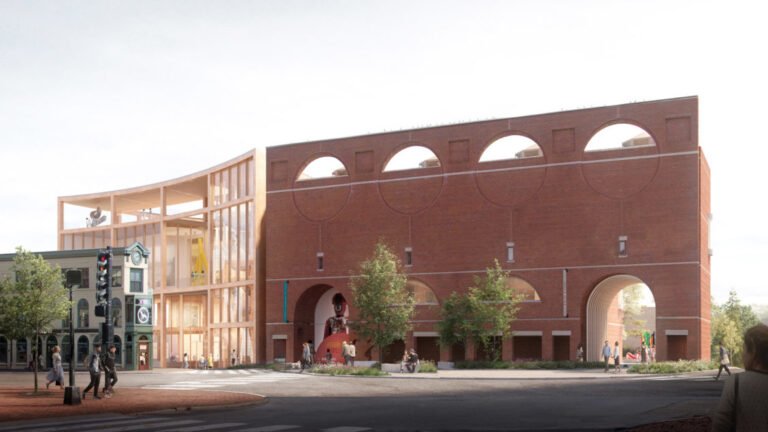Media Scapes in China: How Tradition and Politics is Shaping Related Media Facades
Media Scapes in China: How Culture and Politics is Shaping Connected Media Facades

Outside of China, media facades usually appear as proud individualists vying for attention at night. In China, however, you can find large groups of media facades with a common message in numerous metropolitan areas. These media facades visually merge multiple skyscrapers into a panoramic entity. But what are the reasons that this phenomenon is unique to China? And how did it start? The Media Architecture Biennale linked culture and politics to provide an answer to the emergence of media scapes in China.

With China’s growing desire to present itself as a major player in the international community, the government has looked for a representative stage to welcome guests for important national and international events. In this way, the panoramic light shows appear as the perfect platform to convey cultural identity and technological leadership and send this message to the worldwide media. The introduction of spectacular light shows, for instance, for the G20 summit in Hangzhou in 2016, the BRICS Summit in Xiamen in 2017 or the 40th Anniversary of Shenzhen in 2018, clearly underline the political ambition. In Shenzhen, the more than 40 connected buildings have created a colorful dynamic panorama scroll of the city’s glorious history in recent decades, landscape and technical innovations.
Philosophical concepts like Confucianism and Yin and Yang have led to notions of harmony and balance in urban design. Further on, Christopher C.M. Lee in his book “Common Frameworks: Rethinking the Developmental City in China” proposes to consider the Chinese city as a monument of its entirety. Modern China, however, has embraced the large scale and the concept of maximum quantities in urban development. The new panoramic media facades seem to combine the traditional concept of entity with large scale and high-tech for luminous night entertainment.
The combination of a panorama with a variety of signs and movements can already be seen in traditional Chinese landscape paintings such as Wang Ximeng’s masterpiece “A Thousand Li of Rivers and Mountains” when the scroll is unrolled in a horizontal direction. Though, the forms and texts in contemporary urban light shows are more expressive than in the historical paintings.

From a technical perspective, it is noticeable that the former leading role of large light installations for entertainment in the United States seems to be waning. New York with its Times Square billboards, and Las Vegas, with its luminous canopy screen for casinos on Freemont Street, have achieved iconic status. However, with smart connected skyscrapers, China seems to dominate the ground for large urban high-tech experiments at night. The country also shows a high interest in a large, unified image rather than in a plurality of smaller subjects. Comparing these nighttime images seems to embody two opposing political attitudes: The capitalist staging of individuals versus a unified public relations story driven by the tight organization of the Chinese Communist Party.

The story telling of the media facade animations are of complex type. Video sequences with nature, architecture, people, text and sound symbolize an optimistic future in megacities. In this way, two worlds that are structurally far apart are merged: Urbanization with high-tech skyscrapers stand in strong contrast to the visualization of romantic, untouched landscapes which the building industry has pushed away. In addition to their political relevance, the light shows also have a significance for tourism as a catalyst for the night-time economy. Economic considerations should not forget the investment costs, with large groups of luminous skyscrapers sometimes budgeting around 100 million USD – possibly a challenge for a state with increasing social inequality. Furthermore, environmentalists and selected lighting designers say that the brightness of Chinese light shows is out of control. The Chinese government is aware of the negative lighting effects and issued a notice against extravagant landscape lighting installations in 2020. This has led to a cautious assessment of new large-scale media facade projects in China.
This unique cultural and political development in China has generated a situation where the government has received the power to control nighttime urban design in terms of light shows. The heavy investments, strategic planning and political ambition demonstrate that China regards this urban form of media interface as an important night-time tool. While opening a bright and colorful window into the world of the Internet of Things, China tries to communicate its national identity and technology leadership inconspicuously but effectively within the country and to a global audience.
For further reading:
Thomas, TS, Schielke and Lin, LM, Ma. 2021. Media scapes in China: The empire of figures transforms into connected media facades. In Media Architecture Biennale 20 (MAB20), June 28–July 02, 2021, Amsterdam and Utrecht, Netherlands. ACM, New York, NY, USA, 6 pages. https://doi.org/10.1145/ 3469410.3469436
Light matters, a column on light and space, is written by Dr. Thomas Schielke. Based in Germany, he is fascinated by architectural lighting and works as an editor for the lighting company ERCO. He has published numerous articles and co-authored the books “Light Perspectives” and “SuperLux”. For more information check www.erco.com, www.arclighting.de or follow him @arcspaces.








